Your Go-To Checklist for Drivers looking to avoid infractions or delays
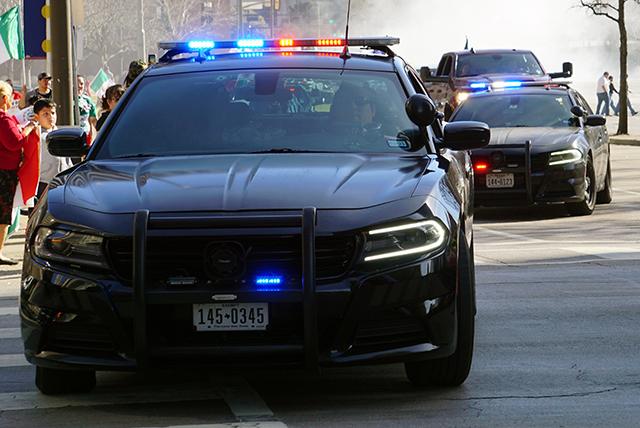
Pulling over for an unexpected check at the side of the highway turns a routine drive into a headache fast. That flashing light in your mirror means paperwork, poking around under the hood, and fingers crossed no violations are found. One slip can mean hours lost, a ticket that bites into your paycheck, or worse, time off the road fixing what you could have caught earlier. Truckers know this drill all too well. Those moments pile on the frustration when you're just trying to hit the next drop point without drama. But here's the good news. A solid routine of checking your rig each morning keeps those stops short or skips them altogether. It lets you focus on the miles ahead instead of worrying about what might go wrong.
Think about it. You've got deadlines breathing down your neck, family waiting at home, and that steady rhythm of the engine lulling you through the night. The last thing you need is a brake line giving out or a tire shredding because you overlooked a small wear spot. Building a habit around these checks turns potential nightmares into quick five-minute tasks. Over time, it sharpens your eye for trouble, saves cash on repairs, and builds confidence behind the wheel. Regulators expect it too. Federal rules demand a close look before every trip, and skipping that step invites real trouble during a random pull-over.
This guide walks you through every key spot to inspect on your semi truck. You'll get a straightforward list to print out or jot down, broken into sections like the cab, engine, brakes, and trailer. Each part includes what to look for, why it matters, and simple ways to test without fancy tools. Then, we’ll pull back the curtain on what actually happens during a roadside inspection – the sequence, the questions, the common traps – so you know exactly how to act when the scale lights flash red. By the end, you'll see how tying into a carrier like Buchanan Hauling and Rigging, Inc. makes all this easier. Their setup supports drivers with top-notch equipment and training that lines up perfectly with these checks. Let's dive in and get you rolling smoother.
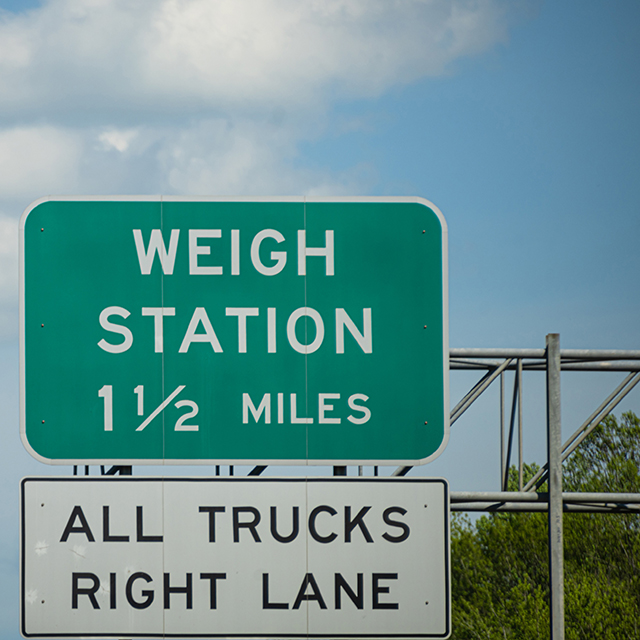
Why These Checks Matter More Than You Think
A clean roadside inspection isn't just about dodging fines. It keeps everyone safer. Data from the Commercial Vehicle Safety Alliance shows that mechanical failures cause thousands of crashes yearly. Brakes alone account for nearly half of out-of-service orders during stops. Catch those issues early, and you avoid the chain reaction. No sudden stops that jack up insurance rates. No extended downtime that kills your earnings. Plus, it eases the mental load. Knowing your truck's solid lets you tune out the what-ifs and enjoy the drive.
Regulations back this up. The Federal Motor Carrier Safety Administration requires a pre-trip vehicle inspection under 49 CFR 396.13. Miss it, and you're looking at penalties up to $2,750 per violation. But it's not all rules and warnings. Drivers who stay on top of maintenance report fewer breakdowns and higher job satisfaction. One veteran hauler shared how his daily ritual cut his repair bills in half over a year. Small investments in time pay big dividends on the road.
Starting with the Cab: Your Command Center
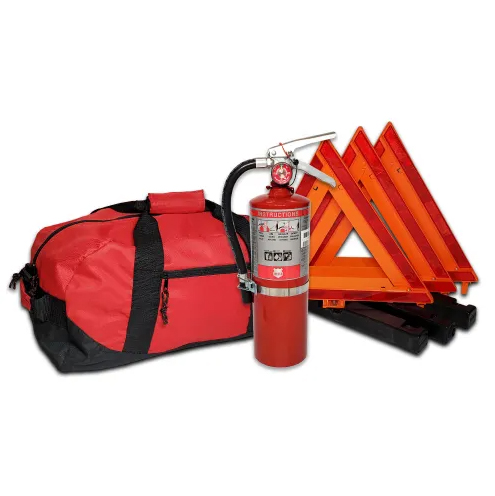
Step into the driver's seat first. This is where control begins, and any glitch here amplifies down the line. Seatbelts come first. Tug hard on the lap and shoulder straps. They should lock without fraying or slack. A faulty belt doesn't just fail an inspection; it leaves you vulnerable in a rollover. Next, fire up the gauges. Oil pressure should climb steady above 40 psi once the engine warms. Air pressure builds to 90-100 psi quick, holding without drops. Low readings signal leaks that could leave you pumping brakes in vain.
Mirrors need a wipe-down. Smudges or cracks distort your view, turning blind spots into hazards. Adjust them so you see the trailer's sides and rear clearly. Windshield wipers sweep clean without streaks or chatter. Test the washers too; a dry spray means poor visibility in rain. Horn blasts sharp and loud. Emergency equipment sits ready: fire extinguisher charged, triangles stacked neat, spare fuses in the glove box. Clutter or expired gear draws inspector eyes fast.
Documentation rounds it out. CDL current? Medical card valid? Logbook up to date? A missing endorsement or hours over log can end your day right there. Keep everything in a waterproof folder within arm's reach. One overlooked permit turned a cross-state run into a nightmare for a buddy of mine. He sat idle for hours sorting it, all because the papers weren't squared away.
Engine Compartment: The Heart of the Beast
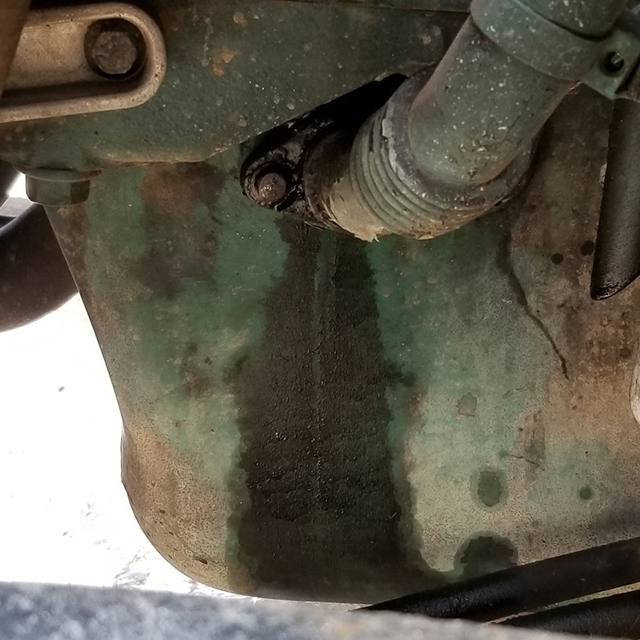
Pop the hood and peer in. Fluids are your lifeline here. Oil level sits between the marks on the dipstick, dark but not gritty. Top it off if low, but hunt for leaks underneath. Puddles of black mean seals failing, and that's a fast ticket to overheating. Coolant fills to the full line, no milky swirls that scream head gasket trouble. Power steering fluid runs clear, reservoir cap tight.
Belts snake around pulleys without cracks or looseness. Press the fan belt; it should deflect about half an inch. Loose ones slip under load, starving accessories like the alternator. Hoses feel firm, no bulges or softness from age. Water pump weeps a drip now and then, but steady streams demand attention. Battery terminals shine free of corrosion, cables secure. A weak start or dim lights trace back here often.
Exhaust stacks clean, no soot buildup hinting at fuel mix issues. Leaks hiss or leave black streaks. The CVSA notes exhaust violations in one out of five inspections. While you're at it, scan for loose wires or brackets. A rattling alternator bracket once cost a driver his alternator mid-haul, stranding him in the middle of nowhere. These checks take under ten minutes but prevent days of headache.

Suspension and Steering: Keeping It Steady
Crawl under the frame next. Tires tell tales first. Tread depth hits at least 4/32 inch on steers, 2/32 on drives. No bulges, cuts, or uneven wear from misalignment. Inflate to the sidewall spec, usually 100 psi for steers. Underinflated rubber heats up fast, leading to blowouts that inspectors love to cite.
Suspension links and bushings show no play. Grab the axle and shake; it should resist without clunks. Air bags, if equipped, hold shape without cracks. Shocks dampen bounces smooth. Loose U-bolts or cracked springs spell trouble on bumpy hauls. Steering gear boxes mount tight, no grease weeping out. Pitman arms connect firm, drag link free of bends.
One driver I know skipped this after a long night. A worn tie rod end gave way on a curve, flipping his load. He walked away, but the rig didn't. Routine shakes save lives and livelihoods.
Brakes: The Ultimate Stopper

No part gets more scrutiny than brakes. Inspectors fail trucks on this alone more than anything else. Start with the air system. Build pressure to governor cut-off, around 120 psi. Listen for leaks at glad hands or valves. Service brake pedal holds steady, no fade after five pumps. Parking brake sets firm, holding the rig on a grade test later.
Slack adjusters push in even, no more than 90 degrees from the cam. Brake pads measure thick, linings free of oil or glazing. Drums show no cracks over three inches or heat scores deep. Chambers match sizes, pushrods without bends. ABS lights glow briefly on startup, then off. A fault code here means electronic issues brewing.
Test it all in a safe spot. Roll slow and stomp the pedal; the truck halts straight without pull. Trailer brakes sync up, no lag. FMCSA data shows proper brakes cut stopping distance by 30 feet at highway speeds. That's the difference between a close call and a wreck.

Lights and Reflectors: Your Nighttime Lifeline
Visibility saves wrecks after dark. Walk the perimeter with headlights on low beam. Headlights pierce straight, not aimed high or low. High beams flip without flicker. Turn signals blink steady, amber front and rear. Brake lights ignite bright red on pedal press, no dim bulbs. Hazard flashers pulse together.
Marker lights outline the rig clean, all 12 if it's a full trailer setup. Reflectors gleam orange and red, no peeled tape or dirt. License plate light bathes the tag even. Clean lenses matter; fogged ones cut output by half. A simple bulb swap fixed a violation for a fleet mate once, but he learned after the fine.
In rain or fog, these keep you seen. Inspectors check every one during Level I stops, and a single out bulb can sidelined you.
Coupling and Trailer: The Tow Behind

Fifth wheel grease shines fresh, no dry spots causing drag. Kingpin latches secure, safety chains crossed and tight. Landing gear cranks smooth, no bends. Trailer frame welds hold without rust holes. Cross members straight, floor boards solid.
Doors latch firm, seals intact against weather. Mud flaps hang level, not torn. If it's a flatbed, securement points bolt tight. One loose pin nearly dumped a load for a guy running reefers. Double-check every hookup.
Final Walk-Around and Test Drive
Circle the whole outfit. No hanging wires, fluid drips, or cargo shifts. Roll it slow: brakes grab even, steering tracks true, no pulls or vibrations. Horn, wipers, all systems go.
This full circle takes 30 minutes tops. Do it daily, and roadside stops become rare nods instead of ordeals.

What to Expect When the Inspector Steps Up: The Real Play-by-Play
You see the scale lights or the cruiser ahead. Heart rate ticks up, but you breathe. Here's the exact sequence most drivers face during a Level I, II, or III inspection – the gold standard roadside stop.
1. The Pull-Ins
Officer waves you onto the scale or shoulder. Kill the engine, set parking brakes, chock wheels if asked. Stay seated until invited out. Grab your paperwork: CDL, medical card, registration, insurance, permits, logbook (paper or ELD printout). Have them ready in a folder – fumbling looks bad.
2. The Greeting & Paper Check
Inspector approaches, badge visible, usually polite but firm. "Morning, driver. License, medical, and logs please." They scan for endorsements, expiration dates, hours violations. Expect questions: "Where you headed? Load type? Any defects today?" Answer short and honest. No jokes about speeding tickets.
3. Walk-Around Begins
You exit, stand where directed – usually driver-side mirror area. Inspector circles the rig with a flashlight and clipboard. They tap tires with a hammer (listening for thuds), eyeball tread, check inflation with a gauge. Lights get flipped on – you may need to hit brakes, turns, hazards from the cab. They crawl under, measure slack adjusters, peek at drums. Hoses, belts, fluids all get a look. One loose airline or cracked lens and they mark it.
4. Cab Interior
Back inside, they check seatbelts, fire extinguisher charge (gauge in green), triangles count and condition. Gauges must read normal with engine running. ELD gets a deep dive: duty status, malfunction codes, unassigned miles. Paper log drivers hand over the grid – they trace every line for form and manner errors.
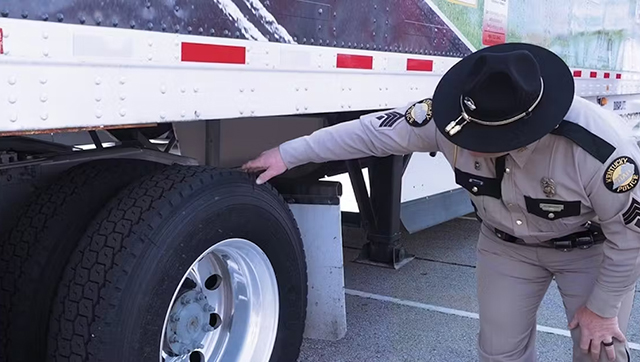
5. The Verdict
Takes 20-60 minutes. Inspector tallies points on the CVSA form. Clean? You get a green sticker or verbal pass. Minor issues? Fix-on-site (bulb swap, tighten chain) or a warning. Out-of-service (OOS)? Red sticker, no rolling until repaired. Brakes, tires, lights, and load securement trigger 80% of OOS orders. You call your carrier; they arrange roadside service or tow. Fines hit the company, but repeated OOS tanks your CSA score and future job prospects.
6. The Exit
Thank the officer, even if you disagree. Ask for clarification on any citation. Safe to roll? Double-check your fixes before merging.
Pro Tip: Record the inspection number and officer name. Snap photos of any disputed defect.
Printable Checklist: Your Daily Ritual
Print the below Roadside Inspection Checklist out by clicking here, laminate if you like, and keep it in the door pocket. Check yes or no, note issues, and report defects immediately.
Cab Section:
- Seatbelts lock firm?
- Gauges read normal (oil >40 psi, air 90+ psi)?
- Mirrors clean, adjusted?
- Wipers/washers work?
- Horn sounds?
- Emergency gear present (extinguisher, triangles)?
- Documents current (CDL, logs, permits)?
Engine:
- Oil level good, no leaks?
- Coolant full, clear?
- Belts/hoses tight?
- Battery secure, clean?
- Exhaust no leaks?
Suspension/Steering:
- Tires tread/inflation good?
- No play in axle/shocks?
- Steering box tight?
Brakes:
- Air builds/holds?
- Pads/linings thick?
- Slack even?
- ABS light off after start?
- Stops straight?
Lights:
- Headlights high/low?
- Turns/brakes/hazards?
- Markers/reflectors clean?
Coupling/Trailer:
- Fifth wheel greased, latched?
- Frame/doors solid?
- Mud flaps intact?
Walk-Around:
- No leaks/drips?
- Test drive smooth?
Real Road Stories: Lessons from the Blacktop
Take Mike, a flatbed hauler out of Indiana. He blew off a tire check once after back-to-back runs. Shredded rubber on I-80, pulling him into the ditch. Two days lost, $1,200 repair. Now he swears by the routine, and his clean inspection streak hit 18 months.
Or Sarah, running dry vans cross-country. A dim taillight got her flagged during a storm. Inspector found it, but let her tape it temporary. She fixed it next stop, but the stress lingered. "One bulb, one hour delay. Not worth it," she says.
Then there's Jake, pulled for a Level I in Arizona. Officer found a cracked brake chamber – OOS on the spot. Jake stayed calm, called Buchanan's 24/7 maintenance line. Shop in Tucson had a tech there in 90 minutes, swapped it, passed re-inspection, back rolling by dinner. No fine, no lost load. "Having a carrier that moves that fast saved my week," he said.
These aren't rare. Forums buzz with tales of minor oversights snowballing. But the flip side shines too. Drivers sticking to checklists boast perfect records, bonuses for safety, and peace of mind.
Choose Your Carrier Wisely - Buchanan Hauling and Rigging, Inc.

Now, imagine running these checks on equipment that's built to last. That's Buchanan Hauling and Rigging, Inc. for you. Started in 1996 by Geary Buchanan, a guy with 24 years hauling under his belt, the company kicked off with one truck and a promise to outwork everyone else. Today, they've grown to over 200 power units and 900 trailers, moving 160,000 loads a year across the United States.
What sets them apart? Experience that runs deep. Their fleet covers dry van and flatbed runs for standard loads, but they shine in the tough stuff. Expedited service gets urgent freight there yesterday. Specialized hauling tackles oversized gear, from machinery to hazmat, backed by certified teams who are trained in securement and handling. Heavy haul division permits routes others dodge, using stretch flats and double drops for loads up to 200,000 pounds.
Expertise shows in every mile. Buchanan's 3PL managed logistics arm plans routes that dodge bottlenecks, factoring in inspection hotspots. Their safety record? Spotless, with quarterly bonuses for drivers who keep it that way. Authoritativeness comes from handling giants like manufacturers shipping conveyor systems or stadium setups. They rigged the massive slabs for Gainbridge Fieldhouse, coordinating permits and escorts without a hitch. Trustworthiness? Family-owned still, treating drivers like kin. Over 600 staff, many long-timers, rave about the support. Weekly pay, pet-friendly hotels during orientation, and flexible home time, daily for locals, weekends for OTR.
For this checklist and inspection prep, Buchanan fits like a glove. Their modern fleet means air-ride suspensions that wear even, ABS brakes calibrated fresh, and telematics alerting to fluid drops before you notice. Maintenance shops at key locations, like Fort Wayne and Houston to help keep you moving. No waiting on parts; they stock common ones. It's why their out-of-service rate hovers near zero. It's E-E-A-T in action: experience from decades hauling, expertise in diverse loads, authority in industry partnerships, trust from transparent ops.
Wrapping Up the Miles: Your Next Step
You've got the tools now to roll with confidence. That checklist isn't a chore; it's your edge against the unexpected. And now you know the inspection dance step-by-step. Print it, use it, own it. When the lights flash, you'll stay calm, prepared, and back on the road fast.
If you're eyeing a carrier that backs this with real muscle, Buchanan Hauling and Rigging, Inc. delivers. Join a team where safety isn't preached—it's practiced, and rewarded.
Ready to haul with the best? Head to their rate quote page for shippers, or check driving ops at about us. For the full lineup, explore our services. Drive Buchanan. Your road just got better.


